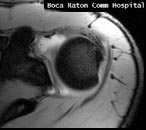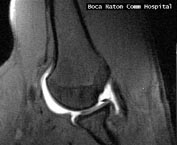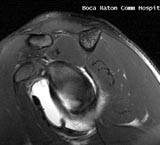Musculoskeletal Cases
Musculoskeletal Cases
Shoulder
MR Arthrography
Knee
Articular Cartilage
Foot & Ankle
Rheumatologic
MRI
3D Helical CT
The most commonly seen shoulder abnormality at MRI are rotator cuff tears
. The arrows in this case, reveal fluid within a large gap where the supraspinatus tendon has completely torn.
MRI arthrography
MR Arthrography is the most accurate method of depicting intra-articular anatomy and pathology, especially in the shoulder and elbow. MR Arthrography allows unparalleled evaluation of capsuloligamentous structures, small chondral defects, and loose bodies, and is particularly useful in young, competitive athletes whose lifestyle depends on accurate diagnosis. Under fluoroscopic guidance, a radiologist inserts a small needle into the joint. Contrast material is then infused to distend the joint, allowing exquisite evaluation of ligament, tendon, and capsular anatomy. Most commonly, MR Arthrography is performed in the shoulder, as it is the most accurate method of characterizing fibrocollagenous labral tears.
Case 1: 20 year old male with shoulder instability. Perthes lesion (Bankart variant). Roll mouse over figures to reveal arrows.
Axial images in neutral position (above) reveals Hill Sachs defect (red arrow, left) and subtle abnormality of the anteroinferior labroligamentous complex (yellow arrows) ABER image reveals avulsion of the anterior labrum from the glenoid rim. The labrum remains partially attached to the scapula by an intact, but medially stripped scapular periosteum (yellow arrow).
Findings are characteristic of a Perthes lesion, which may require probing to detect arthroscopically.Sagittal image reveals contrast imbibing into the anterior labral tear (yellow arrow). Note also a tear of the posterior labrum (red arrow) Shoulder impingement is a dynamic process. In addition to imaging our patients in the neutral position, we routinely image our MR Arthrography patients in the Abduction-External Rotation (ABER) position, which is particularly useful for evaluating athletes involved with repetitive overhead activity, such as pitchers, volleyball players, and swimmers. By stretching out the joint capsule and distending it with fluid, we are able to visualize labroligamentous pathology and small undersurface rotator cuff tears that would otherwise go undetected. MR Arthrography with ABER is able to precisely define the involvement of cartilaginous, labral, and ligamentous structures.
Case 2: 24 year old male who had recurrent shoulder dislocations. A routine MRI shoulder was unable to clearly visualize capsulolabral structures since the patient had no significant native joint fluid. The referring physician requested an MR arthrogram be performed to allow ideal evaluation of the joint. Note the anterior labral tear
with articular cartilage avulsion (red arrow) and the posterior labral tear
(yellow arrow).
Case 3: 32 year old baseball pitcher with a superior labral tear (SLAP tear), seen in the coronal plane
and in the same case, where a long portion of the biceps tendon is visualized to its anchor in the ABER position
.
Case 4: 18 year old wrestler with extensive tear at the anteroinferior labroligamentous complex (Bankhart lesion) following shoulder dislocation, seen in this ABER image
Knee
Historically, the knee was the first joint to be studied by MRI. It remains the most commonly imaged joint referred for MRI. The most frequent clinical indication that patients are sent for MRI of the knee is to evaluate for meniscal tear
(arrows). Sports injuries, such as bone contusions and anterior cruciate ligament tears
(arrows) are exquisitely imaged by MRI.
Articular Cartilage
High Resolution axial T2 weighted image reveals denudation of articular cartilage
overlying the apex of the patella (red arrows). Note normal thickness of articular cartilage (blue arrows) overlying the femoral trochlea and medial and lateral patellar facets.
Coronal T2W image of the ankle reveals a tiny articular cartilage fissure
overlying the talar dome (red arrow). Tiny chondral defects such as these, while symptomatic and clinically important to recognize, are only able to be resolved with high-resolution, signal rich MRI sequences.
Foot & Ankle
The foot and ankle constitute the most anatomically complex joints, which a large spectrum of pathology. Patients freqeuntly present with a spectrum of abnormalities that can be difficult to evaluate clinically. MRI is an important adjunct to developing a therapeutic plan. The Achilles tendon
is the strongest tendon in the ankle, and the most commonly injured with running (arrows indicate an enlarged tendon, reflecting chronic tendintis). Abnormalities of the posterior tibial tendon
are well visualized by MRI, such as in this case where the tendon is markedly enlarged (arrows), reflecting a hypertrophic tear.
Patients with pain at the forefoot may have equivocal symptoms, involving a variety of causes. Morton Neuromas
well depicted at MRI, and MRI is best able to differentiate this mass of scar tissue from other abnormalities which may present with similar symptoms, such as bursitis and stress fractures. Note the arrows in this case, indicating a mass at the second interspace, typical of perineural fibrosis.
Foot infections are a common problem, especially in diabetics. MRI is the most definitive and accurate method of diagnosing the presence and extent ofbone infection in the lower extremity. Note this case of a patient with osteomyelitis
involving both sides of the proximal joint of the second toe.
MRI in Arthritis & Rheumatology
MRI is much more sensitive at detecting erosions than x-rays. Utilizing high resolution submillimeter 3D MR imaging and dedicated MR units, we are able to detect erosions far earlier and with greater reliablilty than ever before. This provides important additional information to rheumatologists who are managing medications to control arthritis. <click here> to learn more.
Real-time 3D Helical CT
See 3D Quicktime movies and learn about the newest innovation in orthopedic imaging for complex fracture evaluation- Real-time 3D Helical CT






